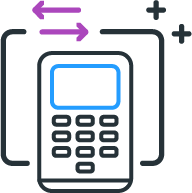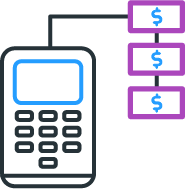•
article
From complicated pricing
But first, what happens when a customer walks into your store and pays with their card?
Let's take a look at each step of the payment process:
 01 A merchant receives their terminal from their payment processor which is linked to their merchant account. A payment processor works with acquiring banks to open merchant accounts, handle payment support, and manage credit and debit processing for merchants.
01 A merchant receives their terminal from their payment processor which is linked to their merchant account. A payment processor works with acquiring banks to open merchant accounts, handle payment support, and manage credit and debit processing for merchants.

02 The customer taps their payment card or smartphone onto the terminal using their Visa, Mastercard, Interac, Apple Pay, Samsung Pay, or Android Pay to start the authorization process.
 03 The terminal sends an authorization request to the customer’s issuing bank via the acquirer. An acquirer is a financial institution that maintains the merchant’s bank account and permits them the right to accept payments.
03 The terminal sends an authorization request to the customer’s issuing bank via the acquirer. An acquirer is a financial institution that maintains the merchant’s bank account and permits them the right to accept payments.

04 The issuing bank or issuer approves or declines the transaction. An issuer is a bank or financial institution that offers credit and issues credit cards to consumers on behalf of the payment brand networks.

05 The acquirer sends notice to the merchant terminal of the approval or denial for authorization of funds.

06 If approved, the customer's funds are removed from their bank account and the transfer of funds begins.

07 All transactions sit on the merchant terminal until the merchant sends the batch of transactions to the processor to be settled usually at the end of the day.

08 The processor deposits funds into the merchant's account via acquirer.
Now you have a better understanding of the payment process, read more about the key players in the payments industry.